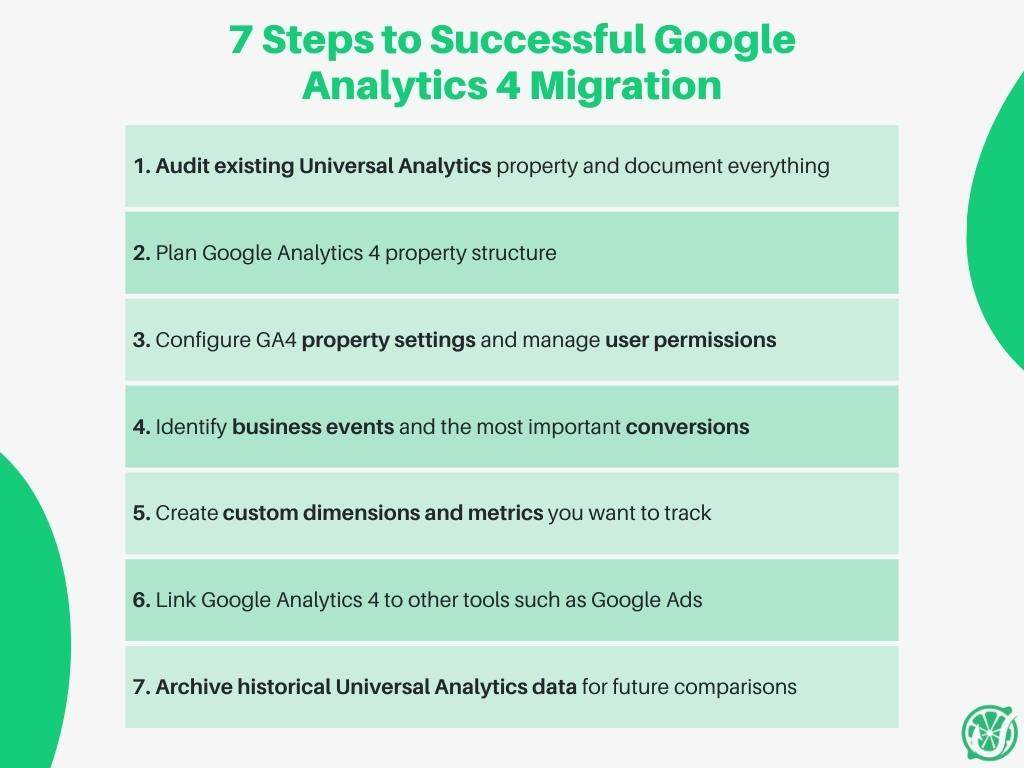
As famous management consultant, Peter Drucker, once said “You can’t improve what you don’t measure.” data plays an essential role in business and digital marketing.
With a sufficient amount of data, we make better future predictions, insights, analyze what marketing tactics works and which don’t. At the end, we make better-educated decisions while optimizing our sites for conversions.
Without data, we’re just another person guessing about what works and doesn’t.
While on March 16th, 2022 Google announced that they will be sunsetting Universal Analytics and the platform will stop collecting new data on 1st of July, 2023.
Google Analytics 4 will be completely replacing Universal Analytics and this announcement brought many concerns and worries within the digital marketing field.
Marketers were desperate to know when they should migrate to Google Analytics 4. What do they need to keep in mind during the migration? What’s the main difference between how Universal Analytics and GA4 collect data? And is it possible to transfer UA data to GA4?
As the result, in today’s article, we’ll share all the most important answers you need to know while migrating to GA4 and how to create a detailed plan to do it successfully.
Google Universal Analytics is Going Away
Why Universal Analytics is Going Away?
Users’ privacy issues were one of the biggest reasons Google is sunsetting Universal Analytics, and that’s mostly due to the privacy issues of transferring data between different continents.
Google Analytics is facing charges from multiple Europe Union member states due to violating privacy laws. Among CNIL (France) and DSB (Austria), Garante (Italy) became the third data protection agency inside EU to ban use of Google Analytics due to GDPR rules violations.
The main problem here was transferring data between EU and U.S. continents and that violates GDPR privacy law. While U.S. companies such as Alphabet Inc. are qualified as “Electronic communication service provider” and is required to hand over the data to U.S. intelligence services on request. Consequently, that means that the U.S. government has easy access to all the personal data of EU citizens.
Can You Transfer UA Data and What’s the Difference Between 2 Platforms?
Unfortunately migrating Universal Analytics data to GA4 won’t be possible due to 2 completely different data models and how the data is being collected on these platforms.
In short, there is a difference in schema and definition of dimensions that make merging data from these platforms not possible. While Universal Analytics data export works based on user session calculations and GA4 data export is very different, and everything is counted based on events.
In addition, GA4 no longer will have goals as Universal Analytics used to, and everything will have to be calculated per conversion within the GA4 user panel.
If we would talk about how users are being calculated, we would see the difference too. While Universal Analytics reports users based on total amount of users, GA4 focuses on active users or the users that have visited the site at least once in the past 28 days.
Despite that, both platform models of collecting data are completely different and it’s not possible to migrate it. However, it will be possible to archive it for at least 1 year longer after Universal Analytics will go away. But we’ll talk about that more in-depth shortly.
Why You Should Migrate to Google Analytics 4 As Soon As Possible?
As mentioned earlier, it won’t be possible to migrate Universal Analytics data to GA4. As the result, you want to start collecting new data as soon as possible. Thus, the sooner you’ll start with GA4 property, the quicker you’ll start populating it with new data.
On the other hand, ideally, you want to have year-over-year data to compare within your properties. For this, you should have set up GA4 before the 1st of July, 2022. As the result, by the 1st of July, 2023 you’ve already collected year-over-year data about your business. But no worries if you haven’t jumped on the train yet, at least make sure to migrate it to GA4 at least as soon as possible.
7 Steps to Successfully Migrate to Google Analytics 4
The bigger your business gets, the more complicated migration process to GA4 will be. However, if you plan it well, and do the checklist homework, it shouldn’t be overly complicated. So without further due, let’s discuss the most important aspects of planning GA4 migration.
1. Audit Universal Analytics Property
To begin with, you want to understand the current status of your Universal Analytics property. Therefore. it’s important to perform an audit.
Create a new document in Google Sheets and document as much information as possible about the current setup of Universal Analytics. Document what goals are you tracking, what custom dimensions have you configured and how many different views have you created. The more information you’ll gather, the easier will be to migrate everything in later stages.
2. Plan the Structure of GA4 Account
Different views are no longer available on GA4, thus carefully plan your account structure. Depending on your business size and difficulty decide on how many properties and data streams you need to set up.
The good thing about this is that GA4 allows you to collect both web and app data within a single property. As the result think of your strategy and if you’re running an online store and have an iOS app, consider connecting both data streams within a single GA4 property.
3. Check Property Settings and User Permissions
Next step should be tackling property settings and user permissions. Document all the property settings you’ve chosen while creating Universal Analytics. Start with the basics such as the time zone and the currency. Analyze how you configured the property.
Later, check your referral exclusion list in UA and what unwanted referrals you want to exclude in GA4. Make sure to check any configured filters within UA and accordingly migrate that to GA4.
Lastly, take care of the user permissions within the account and smoothly transfer these to GA4. Appropriately assigning the correct permissions. Do your team member need to have the Administrator role, or Editor or Analyst is sufficient? Think about it and carefully plan how you divide all these roles.
4. Identify Events and Setup Conversions
When you are ready to migrate events to GA4 analyze what events have you created in UA and how important they’re to your business. Keep in mind that GA4 event model is calculated differently, thus that requires scrupulous planning.
Some tools can help you transfer events from UA to GA4, however, we would advise you to create them from scratch to have complete control over your data, as well as to unlock the full potential of the new event model.
It’s important to understand that GA4 events tracking go way beyond a category, action, and label. Now GA4 offers more flexibility and freedom in creating and tracking custom parameters. You should keep in mind, that some of the enhanced events GA4 tracks automatically such as page view, file download, or video watch progress. Thus there’s no need to waste time and re-create these events again.
Lastly, one significant change moving from UA to GA4 is that the latter no longer has goals. Think of what goals were important tracking for your business and re-create them as the conversions in GA4. Though, we should mention that GA4 now increased the number of conversions and now you can setup up to 30 conversions per GA4 and up to 50 in a 360 property.
5. Create Custom Dimensions and Metrics
Talking about custom dimensions migration, it’s important to consider the difference between the two.
To be precise, it’s important to consider the notion of schema which determines which events specifically apply to a dimension.
And there are four levels of scope: Session, Hit, Product, and User. While custom dimensions within GA4 property differ because they’re calculated per event or user scope base. In other words, they should be described as an event or user based.
When you create custom parameters in GA4, don’t forget to register them as custom dimensions or metrics. In total, you can setup up to 50 event dimensions, 50 custom metrics, and up to 25 user-based custom dimensions.
6. Link GA4 to Other Tools
Don’t forget to check which tools you have linked to your Universal Analytics account. And accordingly,- recreate them in your newly created GA4 property.
7. Take Care of Historical Data
This step is the most controversial, because every business worries about losing their hard-collected data. And once Universal Analytics will go away it might be lost.
And due to the known fact that data migration from UA to Google Analytics 4 isn’t possible because of different data collection models it only makes use more anxious. However, let’s put the stress outside, and let me tell you that it’s still possible to export your data and archive it at least 1 year longer after Universal Analytics will go away.
There’re 3 main methods available to archive data:
- Use Universal Analytics built-in export option. This option could be helpful only if you want to export a few reports within a certain timeframe and can become quite clumsy if you increase the timeframe or the number of reports. After generating the report, you can download it in PDF, XLSX, CSV, and Google Sheets formats.
- Another method to export data is through Google Analytics Dev Tool. And you might have already heard about this before since it’s quite a popular tool to build UTM parameters for building advertising campaigns. GA Dev Tool has a query explorer tool that allows you to export historical UA data based on timeline, metrics, dimensions, and other filters to segment your data.
- The last step could be done through Google Analytics Sheets Add-on. This is a relatively complicated option, however, it directly connects to the Sheets, and you don’t have to take any extra steps to download and upload your data. Name your report, select Analytics view as the data source, configure the report, include metrics, dimensions, segments, and run the tool to generate the report.

(7 Steps checklist to successful Google Analytics 4 migration)
Bonus Point
3 Alternatives of Google Analytics 4
We understand that mastering GA4 can become quite a complex and time-consuming task, and sometimes you just need a simple tool to track traffic and actions people take on your site. As the result, we share our top 3 alternative tools to GA4.
1. Clicky Analytics
Clicky is said to be the number one ‘real-time analytics’ solution right now, that offers cookieless tracking by default.
It offers all the same basic analytics features as GA4, including traffic sources, page clicks, and more. Next to that, it gives more advanced tools such as optimizing with heat mapping and uptime monitoring.
While Clicky’s specialty is real-time traffic monitoring, its ‘Spy’ feature goes through the roof and gives real-time tracking data on your site. It also has an excellent bot detection system, that helps you to get rid of all the referral spam so you can see the real human data.
2. Kissmetrics
Kissmetrics is a product and marketing analytics tool that provides you with in-depth look at who are your customers and how they interact with your site.
The tool puts a heavy emphasis on tracking actions of individual people and customers to create a bigger picture of how users are progressing through your sales funnel. With that in mind, you can accurately track the drop-offs moments and monitor the entire customer behavior from the first touch point with your site until exit point.
3. Piwik Pro
Piwik Pro is a fully stacked analytics tool that was initially built with users’ privacy in mind and it’s an amazing tool for businesses dealing with sensitive users’ data such as healthcare providers or governmental institutions.
The tool has all the features you would need to track users’ behavior, from providing accurate data about your website visitors, to gaining valuable insights into their behaviors and creating detailed reports.
The tool has a powerful Tag Manager feature inside that allows you to put an extra layer of privacy data protection since all the collected and activated customer data remains in safe storage inside the software. Also, it provides cookie consent management features to help you manage all of your consent tasks and customize them without leaving the tool.
Lastly, the tool has been built with large-scale business teams in mind, as the result, they only offer two pricing plans, core, and enterprise. While the core plan is a lightweight version of it and is available for free, the enterprise version is meant for larger businesses who need unlimited use. That said the latter option gets a custom quote.
Conclusion
In conclusion, data plays an important role within each marketing department, and making important decisions without data backup is just another guesswork.
As the result, we still have more than a half year to prepare for GA4 migration, while UA will be sunsetting on July 1st, 2023. However, the sooner you’ll migrate to GA4, the more information you’ll collect.
While migration process to GA4 can become quite complex and intimidating. To better prepare for it you should plan it accordingly, and the following checklist will help you:
- Audit the existing Universal Analytics setup and document everything
- Since GA4 no longer has different views, plan well the new property structure
- Update new property settings and manage users’ permissions
- Identify the main events and consider which of them could be defined as conversions
- Create custom dimensions and metrics
- Link Google Analytics 4 to other tools such as Google Search Console or Google Ads
- Archive the historical data from Universal Analytics
Lastly, to some folks, GA4 can become too difficult to master, and they would rather get something less complicated. And the tool to see the entire customer journey on your site would be sufficient. Among the most popular alternative tools to Google Analytics 4 consider getting Clicky Analysis, Kissmetrcis, or Piwik Pro.




